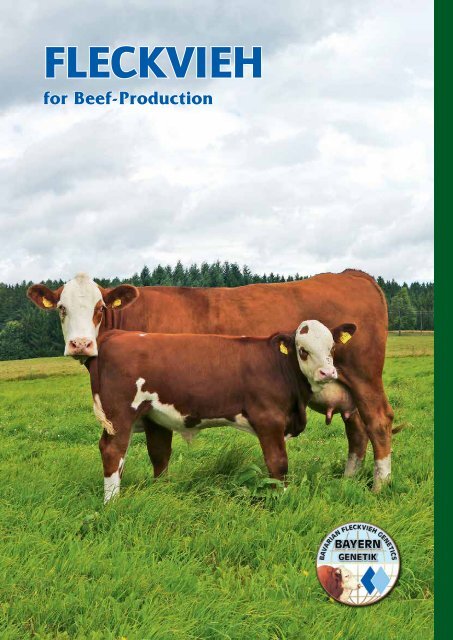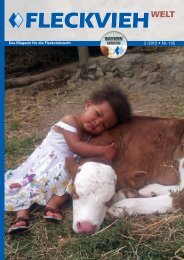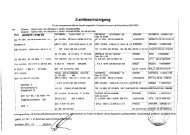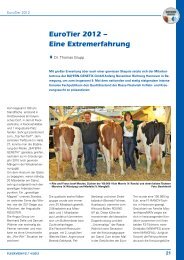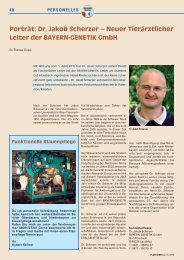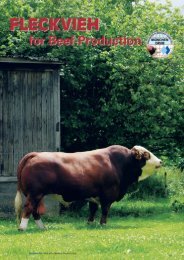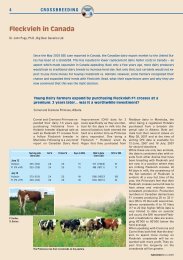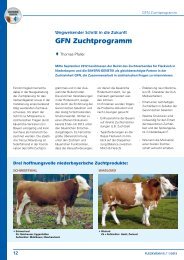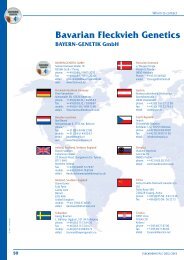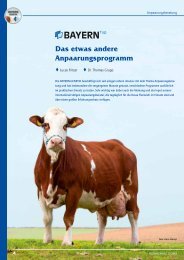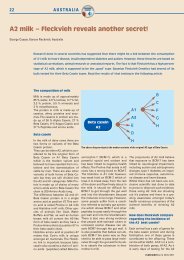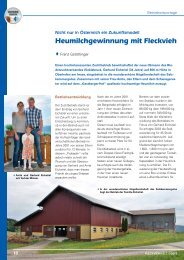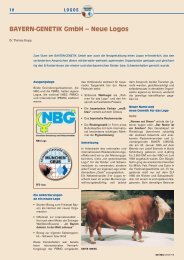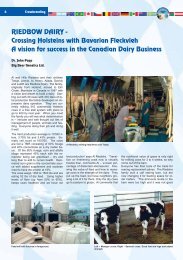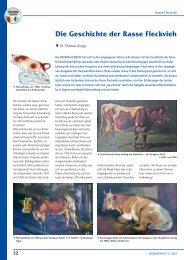Simmentaler-Fleckvieh breeding in Namibia
Simmentaler-Fleckvieh breeding in Namibia
Simmentaler-Fleckvieh breeding in Namibia
Create successful ePaper yourself
Turn your PDF publications into a flip-book with our unique Google optimized e-Paper software.
FLECKVIEH<br />
for Beef-Production
August Stauch –<br />
the trigger for the<br />
diamond rush<br />
The granddad of Mike Krafft,<br />
August Stauch, son of a farmer<br />
from Ettenhausen/ Thur<strong>in</strong>gia/<br />
l Young bulls are kept on a separate pasture<br />
and fed some extra feed to prepare them for the auction.<br />
Liv<strong>in</strong>g history<br />
<strong>Simmentaler</strong>-<strong>Fleckvieh</strong><br />
<strong>breed<strong>in</strong>g</strong> <strong>in</strong> <strong>Namibia</strong><br />
l Dr. Thomas Grupp, CEO of BAYERN-GENETIK GmbH<br />
<strong>Namibia</strong><br />
The struggle with asthma was the reason for two families to start a new life <strong>in</strong> the southwest of<br />
Africa at the beg<strong>in</strong>n<strong>in</strong>g of the 19th century. The history of the families Stauch and Krafft is not<br />
only connected with the positive economical development of this very dry country dur<strong>in</strong>g the past<br />
105 years, but it also shows how efficient agriculture and especially <strong>Fleckvieh</strong> <strong>breed<strong>in</strong>g</strong> can be<br />
under adverse climatic conditions, when hard work and pioneer<strong>in</strong>g sense come together.<br />
Mike Krafft, a highly respected <strong>Fleckvieh</strong> expert from <strong>Namibia</strong>, who also has a profound knowledge<br />
<strong>in</strong> hunt<strong>in</strong>g, sheep <strong>breed<strong>in</strong>g</strong>, medical plants, history and municipal services, tells us the<br />
history of these two families.<br />
Germany, went to the former<br />
colony Deutsch-Südwestafrika <strong>in</strong><br />
the year 1906, because he had a<br />
lung disease and a lung specialist<br />
told him, that the dry desert<br />
climate would be good for him.<br />
He signed up as headman <strong>in</strong><br />
railroad construction through the<br />
Namib Desert for two years.<br />
Liv<strong>in</strong>g <strong>in</strong> one of the most godforsaken<br />
corners of the world, August<br />
Stauch only had two options:<br />
get alcohol-addicted or f<strong>in</strong>d<br />
a worthwhile activity. As he<br />
always was <strong>in</strong>terested <strong>in</strong> nature<br />
and m<strong>in</strong>eralogy, especially <strong>in</strong><br />
plants, <strong>in</strong>sects, the starry sky and<br />
diamonds, he asked his workers<br />
to watch out for tw<strong>in</strong>kl<strong>in</strong>g stones.<br />
One day, one of his black workers,<br />
Zacharias Lewala, brought<br />
46 FLECKVIEHWORLD 2012/2013
<strong>Namibia</strong><br />
l Stompie, son of Hauk Edgar, who himself is a Hauk Erz son, Junior-Champion<br />
2012, Senior-Champion 2011 <strong>in</strong> W<strong>in</strong>dhoek–Type bull for <strong>Namibia</strong>.<br />
him a stone, of which he was<br />
<strong>in</strong>tuitively conv<strong>in</strong>ced that it was<br />
a diamond after he thoroughly<br />
tested it: acid treatment, scrap<strong>in</strong>g<br />
on a watchglass, hammer<br />
blows. At that time, nobody<br />
could imag<strong>in</strong>e that diamonds<br />
can be found that far from their<br />
mother rock, Kimberlit, <strong>in</strong> the<br />
middle of the desert. People<br />
shook their heads and thought<br />
that Augus Stauch might have<br />
had too much sun. Obsessed<br />
from the idea, August Strauch<br />
quit his job with the railroad<br />
construction company and prepared<br />
an expedition together with<br />
the geologist Dr. Paul Scheibe.<br />
On horseback and camels they<br />
rode south, follow<strong>in</strong>g the vegetation<br />
l<strong>in</strong>e. One night, when the<br />
full moon lightened the desert,<br />
they saw tw<strong>in</strong>kl<strong>in</strong>g everywhere.<br />
The desert ground was dotted<br />
with diamonds ly<strong>in</strong>g bare due to<br />
the constant desert w<strong>in</strong>d! Stunned<br />
by the sight, August Stauch<br />
named the area „Märchental“<br />
(Fairytale Valley). The discoverers<br />
kept their f<strong>in</strong>d a secret and applied<br />
for the m<strong>in</strong><strong>in</strong>g rights for an<br />
area of 33 ha at Kohlmannskuppe<br />
and sent a rock sample to<br />
Berl<strong>in</strong>/Germany. When the results<br />
proved it was really diamonds<br />
what they found <strong>in</strong> the<br />
Namib Desert, the whole country<br />
was caught by a diamond rush.<br />
People stopped call<strong>in</strong>g August<br />
Stauch a weirdo immediately.<br />
From 1910 to 1914, each year<br />
1,3 Mio. carat were dug from the<br />
Namib Desert.<br />
After World War One, August<br />
Stauch almost lost his whole<br />
fortune to the South African<br />
State. However, he negotiated<br />
with Ernest Oppenheimer, the<br />
founder of De Beers Company to<br />
the good of the employees and<br />
rema<strong>in</strong>ed the company director<br />
till 1924.<br />
Development of farm<strong>in</strong>g<br />
Be<strong>in</strong>g a son of a farmer, August<br />
Stauch was very <strong>in</strong>terested <strong>in</strong> the<br />
development of agriculture <strong>in</strong> his<br />
new home country and besides<br />
the diamond bus<strong>in</strong>ess, established<br />
an own farm.<br />
1911<br />
Purchase of the Farm Haribes<br />
near Maltahöhe<br />
1921<br />
Purchase of the Farms Ibenste<strong>in</strong><br />
and Dordabis, Hochfels at the<br />
Komashochland and Rietfonte<strong>in</strong>block<br />
near Grootfonte<strong>in</strong><br />
l <strong>Fleckvieh</strong> heifers on extensive pasture on farm Ibenste<strong>in</strong>.<br />
At Haribes karakuls were bred, a<br />
sheep breed that was imported<br />
already <strong>in</strong> 1907 to produce Persian<br />
Lamb. At Dordabis, August<br />
Stauch built up an abattoir for<br />
cattle, sheep and pigs. In Rietfonte<strong>in</strong><br />
he founded a dairy, which<br />
was closed down <strong>in</strong> the year<br />
2005, after a changeful history.<br />
August Stauch aimed at creat<strong>in</strong>g<br />
market opportunities for farmers<br />
to boost the economy of the<br />
country. On his <strong>in</strong>itiative the<br />
Land & Settlement Bank was<br />
founded, which helped farmers<br />
to get loans.<br />
August Stauch was a man of<br />
action, who f<strong>in</strong>anced his immense<br />
<strong>in</strong>vestments by loans despite<br />
of his big wealth earned <strong>in</strong> the<br />
diamond bus<strong>in</strong>ess.<br />
In the 1930ties he had to pay<br />
dearly for the dependence on<br />
credit capital. He did not see the<br />
world economic crisis com<strong>in</strong>g<br />
and his whole property was<br />
liquidated <strong>in</strong> 1932. In 1937 he<br />
came back to Germany and<br />
enrolled at the University of<br />
Breslau where he studied mathematics<br />
and physics. After the<br />
<strong>in</strong>vasion of the Red Army <strong>in</strong><br />
1945, August Stauch moved<br />
back to his hometown Ettenhausen,<br />
where he died on the 11th<br />
of May 1947 as a poor man.<br />
The Krafft family –<br />
from Russia<br />
to Südwestafrika<br />
Mike Kraffts grandparents flew<br />
from Moscow <strong>in</strong> 1918 and found<br />
a new home <strong>in</strong> Freiburg/Breisgau/Germany.<br />
His father Nicolai<br />
studied eng<strong>in</strong>eer<strong>in</strong>g and worked<br />
<strong>in</strong> Paris. S<strong>in</strong>ce he had a lung<br />
disease, physicians sent him to a<br />
sanatorium at Davos /Switzerland,<br />
where he, as luck would<br />
have it, met August Stauch, who<br />
told him about the favourable<br />
climate <strong>in</strong> Südwestafrika. Inspite<br />
of the fact, that physicians gave<br />
Nicolai Krafft only two more<br />
years to live, he immediately<br />
decided to emigrate to this dry<br />
country, where he aga<strong>in</strong>st all<br />
expectations lived on for many<br />
years.<br />
After its liquidation <strong>in</strong> 1932,<br />
Nicolai Krafft and his uncle<br />
founded the Dordabis Farm<br />
Cooperative and took over the<br />
mortgage from the farms Ibenste<strong>in</strong><br />
and Dordabis. Already <strong>in</strong><br />
1936 this cooperative was disbanded<br />
and the farms were<br />
separated.<br />
Mike Kraffts mother was a famous<br />
artist, whose artworks were<br />
exhibited <strong>in</strong> several galleries.<br />
FLECKVIEHWORLD 2012/2013 47
Mikes granddad came from Russia,<br />
where he was work<strong>in</strong>g <strong>in</strong> the<br />
cotton bus<strong>in</strong>ess. He came as far<br />
as Buchara, which at that time<br />
was controlled by the Russians<br />
and where he became acqua<strong>in</strong>ted<br />
with carpet production from<br />
karakul wool. This gave the impetus<br />
for the foundation of the<br />
karakul <strong>breed<strong>in</strong>g</strong> and a weav<strong>in</strong>g<br />
mill at Ibenste<strong>in</strong> farm.<br />
Mike Krafft –<br />
an all-rounder<br />
Inspite of the fact that he is<br />
already 74 years old, Mike Krafft<br />
is burst<strong>in</strong>g with lust for life. He<br />
still assists his son René, who<br />
took over the farm <strong>in</strong> March<br />
2012. The daily shores and his<br />
hobbies swimm<strong>in</strong>g and cycl<strong>in</strong>g<br />
keep him <strong>in</strong> shape.<br />
Already s<strong>in</strong>ce 1924 Simmental/<br />
<strong>Fleckvieh</strong> is kept on the Ibenste<strong>in</strong><br />
farm. In that year August Stauch<br />
imported his first animals, however<br />
the first <strong>Fleckvieh</strong> animals<br />
ever came off a ship <strong>in</strong> 1893 at<br />
Swakopmund and then had to<br />
walk the exhaust<strong>in</strong>g way to<br />
l Mike Krafft, read<strong>in</strong>g the <strong>Fleckvieh</strong><br />
Show catalogue at W<strong>in</strong>dhoek.<br />
W<strong>in</strong>dhoek. In the year 1896 a<br />
devastat<strong>in</strong>g R<strong>in</strong>derpest epidemic<br />
killed nearly all cattle <strong>in</strong> southern<br />
Africa. Further cattle imports<br />
aga<strong>in</strong> were threatened by the<br />
R<strong>in</strong>derpest Virus, however an<br />
antiserum was developed <strong>in</strong> a<br />
short time, which made it possible<br />
to avoid severe damage. When<br />
the farm was separated <strong>in</strong> 1936,<br />
also the <strong>Fleckvieh</strong> cattle were<br />
sold. Not until 1958, when Mike<br />
had to quit his studies <strong>in</strong> South<br />
Africa after the death of his<br />
father, the Sussex-cattle were<br />
culled <strong>in</strong> agreement with his<br />
mother and <strong>Simmentaler</strong> came to<br />
the farm aga<strong>in</strong>. Only who understands<br />
nature and does not work<br />
aga<strong>in</strong>st it, will be a successful<br />
farmer <strong>in</strong> <strong>Namibia</strong>. This is especially<br />
true for European cattle<br />
breeds, which have to be adapted<br />
to the country and its realities.<br />
The farms Ibenste<strong>in</strong> and Dordabis<br />
together comprise 15.000 ha<br />
of land. Two herds are kept on<br />
the farmland, a commercial herd<br />
with 180 Simbrah cows and a<br />
registered <strong>breed<strong>in</strong>g</strong> herd with<br />
75 cows. In order to avoid overgraz<strong>in</strong>g,<br />
a benchmark figure of<br />
12,5 ha per livestock unit,<br />
(8 - 10 ha for younger animals) is<br />
determ<strong>in</strong>ed. This immense need<br />
of land maybe is the biggest<br />
problem <strong>in</strong> Southwestafrica. In<br />
average, the annual precipitation<br />
is 300 mm, however, dur<strong>in</strong>g the<br />
last two years there were exceptional<br />
500 and 600 mm of ra<strong>in</strong>fall.<br />
Surpris<strong>in</strong>gly this did not lead<br />
to a better growth of the grassland,<br />
<strong>in</strong>stead weeds like Speikraut<br />
and Nikorella got out of<br />
control.<br />
Up to the 80ties game was kept<br />
on the same pastures like cattle.<br />
However, game needs more<br />
fenc<strong>in</strong>g than cattle and the game<br />
always went to the pastures with<br />
the better grass. Therefore 6.500<br />
ha were enclosed with game-save<br />
fences. Especially dur<strong>in</strong>g the dry<br />
periods an eye hast o be kept on<br />
these areas to avoid overgraz<strong>in</strong>g.<br />
Already when he was very young,<br />
Mike took his pilot’s license and<br />
flew around <strong>in</strong> Africa. From the<br />
bird’s eye view he was able to<br />
watch good and poor pasture<br />
management on different farms,<br />
a very useful experience.<br />
Cattle <strong>breed<strong>in</strong>g</strong><br />
<strong>in</strong> <strong>Namibia</strong> – a challenge<br />
The most important po<strong>in</strong>t for<br />
successful cattle <strong>breed<strong>in</strong>g</strong> <strong>in</strong><br />
<strong>Namibia</strong> is selection for fertility<br />
– accord<strong>in</strong>g to the pr<strong>in</strong>ciple that<br />
a lean cow with a calf is better<br />
than a round cow without a calf.<br />
Heifers and cows that do not get<br />
pregnant dur<strong>in</strong>g mat<strong>in</strong>g season<br />
(February – April) are slaughtered<br />
without any exception. On the<br />
farm of Mike Krafft mat<strong>in</strong>g is<br />
only done by natural service,<br />
which means that he has to have<br />
a good eye when select<strong>in</strong>g <strong>breed<strong>in</strong>g</strong><br />
bulls. Dur<strong>in</strong>g the 60ties<br />
<strong>breed<strong>in</strong>g</strong> cattle were imported<br />
from Germany and Austria, however,<br />
these animals did not meet<br />
his expectations. The neighbour<br />
country South Africa and the<br />
<strong>Namibia</strong>n <strong>breed<strong>in</strong>g</strong> colleagues<br />
had the better bulls. One of the<br />
reasons was that these bulls<br />
already were adapted to the<br />
southern African climate.<br />
Calves are weaned with 8 months<br />
dur<strong>in</strong>g the dry period, when it is<br />
w<strong>in</strong>ter <strong>in</strong> southern Africa. It is<br />
essential to offer the young animals<br />
an appropriate m<strong>in</strong>eral feed<br />
(concentrate with phosphate and<br />
micronutrients), <strong>in</strong> order to avoid<br />
that they lose weight dur<strong>in</strong>g<br />
ra<strong>in</strong>-season. The phosphor con-<br />
<strong>Namibia</strong><br />
tent of the <strong>Namibia</strong>n soil is too<br />
low and when you don’t offer<br />
phosphoric m<strong>in</strong>eral feed to the<br />
animals they will lick bones ly<strong>in</strong>g<br />
around on the pastures, which<br />
might cause botulism.<br />
The cheapest and most important<br />
source of feed are pastures,<br />
therefore Mike pays great attention<br />
to pasture management. He<br />
keeps an eye on the growth of<br />
weeds and bushes, which reduce<br />
the quality and the yield of the<br />
pastures a lot. Bushes are eradicated<br />
mechanically and chemically.<br />
Game automatically attracts wild<br />
animals like cheetahs and leopards.<br />
Each year the farm loses<br />
about 15 calves to these big cats.<br />
Poisonous snakes (Puffadder,<br />
Cobra, Mamba, Tigersnake) are<br />
numerous, however they are less<br />
risky than one would th<strong>in</strong>k.<br />
The weaners are marketed on<br />
local auctions at W<strong>in</strong>dhoek and<br />
Rehoboth. The cattle are sold to<br />
South African feedlots. Normally<br />
male weaners are castrated, if<br />
they are not needed for <strong>breed<strong>in</strong>g</strong>.<br />
The steers are kept on special<br />
pastures and brought to the coop<br />
abattoir Meatco together with<br />
the slaughter cows and the bulls<br />
that are not needed for <strong>breed<strong>in</strong>g</strong><br />
purposes. The best meat cuts are<br />
exported to Europe, the forequarters<br />
are marketed <strong>in</strong> <strong>Namibia</strong> or<br />
South Africa. Currently, the<br />
slaughter price for steers is<br />
K 2,30 per kg, for slaughter cows<br />
it is about K 1,80 – 2,00 per kg,<br />
young animals are sold for<br />
K 2,40 and 2,50 per kg.<br />
An excellent <strong>Fleckvieh</strong> bull for<br />
natural mat<strong>in</strong>g costs about<br />
K 4.000 and K 5.000, <strong>in</strong> times<br />
when the demand is high, prices<br />
might double. 95 % of the bulls<br />
48 FLECKVIEHWORLD 2012/2013
<strong>Namibia</strong><br />
l Mike Brooke/Breedplan hands over a certificate to Mike Krafft for the bull with<br />
the highest Blup Breed<strong>in</strong>g Values at W<strong>in</strong>dhoek-Show 2011.<br />
are sold to extensive farms, only<br />
5 % to selected <strong>breed<strong>in</strong>g</strong> farms.<br />
The <strong>breed<strong>in</strong>g</strong> bulls have to be<br />
structural sound and have to<br />
have excellent feet and legs as<br />
they have to move around and<br />
do their job on the large pastures.<br />
The best <strong>breed<strong>in</strong>g</strong> values do<br />
not help, if an animal has bad<br />
feet and legs! In Mike’s op<strong>in</strong>ion<br />
the <strong>in</strong>dex for birth weight can be<br />
slightly higher, because the trait<br />
birth weight is connected to<br />
growth. If you focus on calves<br />
with a low birth weight, the<br />
whole herd gets smaller. If you<br />
then decide your cows are too<br />
small and want to use bulls with<br />
higher birth weights aga<strong>in</strong>, you<br />
will get dystocias, which should<br />
be absolutely avoided with extensive<br />
farm<strong>in</strong>g.<br />
The Breedplan-System used <strong>in</strong><br />
southern Africa gives you a good<br />
overview. If you feed the system<br />
regularly with your <strong>breed<strong>in</strong>g</strong><br />
data, it helps you to figure out<br />
important tendencies <strong>in</strong> advance.<br />
In the past two years Mike Krafft<br />
had an enormous success with<br />
his <strong>Simmentaler</strong> herd of on vari-<br />
ous cattle shows. The „Super cow<br />
2011“ for the trait fertility and<br />
the „Senior-Champion Cow<br />
2011“came from his herd. His<br />
bulls were awarded Junior-Champion<br />
and Calf-Champion. 10 out<br />
of 12 animals he presented at<br />
the W<strong>in</strong>dhoek Show, won a price.<br />
A polled grandson of BFG Eisenherz<br />
PP performed excellently on<br />
his farm and a major part of<br />
Mike’s success on shows goes<br />
back to this sire.<br />
Mike Krafft – a farmer<br />
with social responsibility<br />
Michael is a social man who still<br />
works for his store at Dobabis<br />
and on his farm, despite of the<br />
fact, that he already is retired. He<br />
is highly respected from his employees<br />
as he helps them whenever<br />
he can. Also his neighbours<br />
like him a lot and ask him for<br />
help before contact<strong>in</strong>g the „official<br />
authorities“. Last but not<br />
least, also the ladies liv<strong>in</strong>g on the<br />
farms Ibenste<strong>in</strong> and Dordabis,<br />
Ida Stauch and Marianne and<br />
Sab<strong>in</strong>e Krafft, the wife of Mike,<br />
had a big <strong>in</strong>fluence on the positive<br />
development of the farm, <strong>in</strong><br />
l Hauk Erz at the show <strong>in</strong> W<strong>in</strong>dhoek. His progeny did well on Mike Kraffts farm.<br />
spite of big strokes of fate. Some<br />
years ago, Sab<strong>in</strong>e and Mike were<br />
attacked and abused by six<br />
gangsters from W<strong>in</strong>dhoek. The<br />
neighbours from a wild settlement<br />
thereupon organized a<br />
public protest aga<strong>in</strong>st this barbarism,<br />
an action which was really<br />
remarkable for <strong>Namibia</strong> and<br />
South Africa.<br />
We take our hats off to Mike and<br />
his big family for their lifework<br />
and wish them all the best for<br />
their future. <strong>Fleckvieh</strong> breeders<br />
from all over the world should<br />
visit this extraord<strong>in</strong>ary farm,<br />
especially if they are <strong>in</strong>terested <strong>in</strong><br />
hunt<strong>in</strong>g and cattle farm<strong>in</strong>g respectively.<br />
<strong>Namibia</strong> is worth a<br />
visit! (www.ibenste<strong>in</strong>.com).<br />
FLECKVIEHWORLD 2012/2013 49<br />
l


